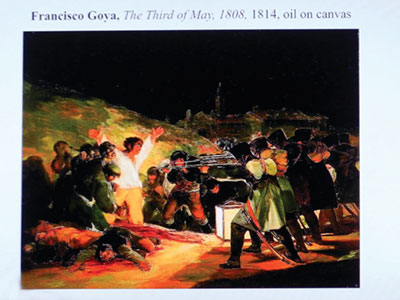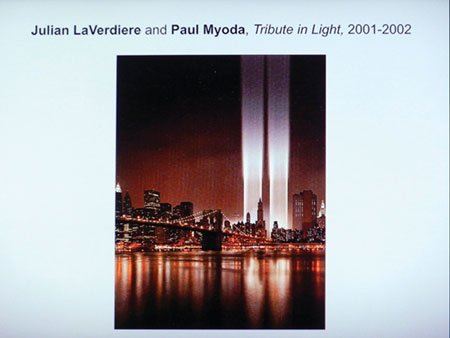
Five weeks in and the criteria for a masterpiece continues to grow. Luckily, the Triton Museum of Art’s Chief Curator, Preston Metcalf, explained the final pieces of criteria on March 6.
To begin, Metcalf recapped what had already been examined – a masterpiece must have ambivalence, irony, strangeness, originality, aesthetic splendor, need to creatively misread its precursors, have cognitive power, be a metaphor, demand re-experiencing, and inspire self-change through character inwardness. He then added the last two pieces – a masterpiece must be larger than any social programming and have achieved anxiety or a fear of mortality.
As complicated as it sounds, the definitions are quite simple. Using Francisco Goya’s “The Third of May,” Metcalf described how the subject (the Spanish resistance to Napoleon’s army in 1808) is universal. “Notice that the French soldiers are faceless,” he said. “They don’t face us. They are automatons. They are nobody and if they are nobody they are anybody and if they are anybody they are everybody. If they’re everybody, they could be us. So are we to identify with the evil in the painting? We have some other nameless, faceless people – the dead. Those about to be executed – covering their faces, hiding their individual identities and they too become everybody. The point is that we are this painting. We possess both of these qualities within us. We have the capacity to be the victim and the inflictor. We can be either and shamefully we are either at any given time … We have the past, the present and the future … This is layer upon layer of meaning that goes far beyond a horrific event that could have been a footnote in history. It now speaks to us.”

Metcalf continued to explain the idea that art speaks to the viewer on a universal level by showing works by Frida Kahlo, Dorthea Lange, Edward Kienholz, and Julian LaVerdiere and Paul Myoda’s “Tribute in Light” – the September 11 light memorial.
He then tackled the topic of masterpieces portraying achieved anxieties or the fear of mortality. “When we’re talking about this fear of mortality,” Metcalf said, “which I don’t want to imply is strictly a fear of death, because that’s not it. It’s a fear of being less because none of us want to be less. We all want to think there’s something grander … This is something that a masterpiece needs to do; it needs to reflect something greater.”
He continued, “Art allows us to look at ourselves. Every great work of art … whether it’s a painting or a sculpture or a story or a song, is about you. That’s it. And if you can come to that then you know you’ve seen a masterpiece and sometimes it takes a lifetime to get there.”
“A Curator’s Eye: Discerning a Masterpiece” concludes on March 13 where Metcalf will show works of art that encompass all of the criteria. Lecture begins at 7 p.m. at 1505 Warburton Ave. Drop in fee is $20.





